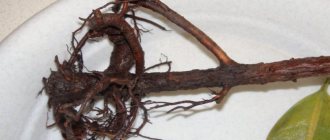What is withering?
Definition
Plant wilting is a disease during which there is a loss of tissue tension.
The plant begins to weaken, wither, its leaves and flowers begin to fall off. In some cases, this can even lead to the death of the plant. Often, wilting occurs at a time when the amount of moisture evaporated is significantly greater than that which enters the plant from the soil. However, sometimes wilting can indicate other problems.
Appearance
As they wilt, the edges and tips of azalea leaves turn a dark brown color. In some cases, the leaf blade may become completely brown, red or yellow (read about changes in the leaf blades of a plant here). Flowers fall off and dry out as they wilt. The branches of the flower become less elastic and weak.
Caring for azaleas after flowering - a practical guide to pruning and replanting
The blooming of azaleas is an amazing sight. During the bud blooming period, the bush brings a feeling of summer and warmth to the room. Azalea blooms in winter, when there is a lack of bright colors and lush greenery. But, unfortunately, the flowering period of the beauty is short. And there comes a time when the gardener should think about how to care for the plant so as not to ruin the crop. If the azalea has faded, what to do next becomes an important issue to ensure sustainable development.
Why do azalea leaves dry and fall off: the main reasons
If we summarize all the possible causes of leaf shedding, they can be divided into 4 main groups:
- improper care;
- reasons related to violation of conditions of detention;
- incorrect transplantation;
- problems caused by diseases and pests.
Improper care
If you find that your rhododendron has begun to wither, its foliage dries, turns black and falls off, the most likely reason is improper care of the plant.
When caring for rhododendron, you need to remember the following points:
- azalea loves sufficient watering and cannot tolerate drying out of the soil, but this does not mean that the soil in the pot should be turned into a swamp, since the roots of the plant react painfully to excess moisture;
- blackened leaves indicate excessive watering;
- Another reason that a plant loses foliage may be improper application of fertilizers;
- redness and subsequent shedding of foliage may be the result of excess or lack of fertilizers (especially phosphorus).
Incorrect conditions
The most common mistakes when creating conditions for growing azaleas:
- crumbling dry leaves covered with brown spots indicate that the air temperature is too high;
- green azalea leaves may fall off due to excessively dry air, especially in winter, during the heating season;
- excessively dry air can also cause a brown, almost black border to appear along the contour of an azalea leaf;
- reddened fallen leaves are most often the result of direct sunlight hitting the flower.
Transplantation during flowering
Another reason that can lead not only to falling foliage, but also to long-term illness and even death of the plant, can be replanting during the flowering period. This applies to all plants in general, since replanting is stressful, and during flowering the plant needs to create conditions of maximum comfort and peace.
Did you know? The most common types of azalea in the world are Indian and Japanese. Based on the name, it becomes clear that the birthplace of the plants is the countries of Southeast Asia. Although in nature there are species of this beautiful flower that can only be found in natural conditions on the American continent.
Plant diseases and parasites
The most characteristic diseases and parasites from which azalea suffers:
- Rust, or gray rot, usually occurs when the temperature regime is not maintained.
- If, in addition to wilting, the flowers turn yellow and fall off, the reason is probably poor-quality water.
- Late blight can occur due to excess moisture.
- Spider mites, strawberry mites, and scale insects are parasites that can be found more often than others on rhododendron.
- Brown, almost black leaves are a sign that the flower is infected with a fungus.
How to care at home?
To detect a problem in a timely manner, the plant should be periodically inspected and damaged and dried parts should be removed. Improper care of azaleas leads to disease and death of the plant.
The azalea needs to be periodically replanted in new soil, watered with melt water, and covered with ice in the summer when it’s hot.
You can read more details about why the azalea withers, or the leaves of the flower turn black and fall off, or the leaves become very light, change color and shape, as well as what to do in these cases, on our website.
Instructions on what to do depending on the reason
Let's consider in detail what to do if:
- Flowers fall off and buds dry out:
- Why does a houseplant drop flowers and how to revive it in this case? Perhaps you were in a hurry to rehome your new pet. Support the root system of the plant - water the substrate with zircon solution.
- Azaleas can only be replanted in the first half of spring. It is advisable to use transshipment to avoid damaging the roots. Select a pot with a circumference 1–2 cm smaller than the crown of the plant. Fill the bottom of the container with drainage.
- Do not move a blooming azalea from place to place.
- The leaves have turned yellow and are falling off. Water only with soft water. If the situation does not improve, then change the soil; perhaps clay soil has gotten into the pot.
- Why do green leaves fall off and what care is needed in this case?
- Examine the plant carefully. If you see the finest threads on the underside of the leaf and in the internodes, then the cause of the trouble is a spider mite.
- Do not forget about daily spraying and treat the azalea and all plants in the apartment with an acaricidal preparation (for example, Fitoverm).
- Brown, even blackening, leaves that the azalea sheds mean that the flower is suffering from a fungal infection. Remove all affected leaves, treat the flower and soil in the pot with fungicidal preparations.
- Now let’s figure out why the leaves of an indoor rhododendron turn red and fly off, what to do if the plant sheds almost all its leaves, and what can be done to save the flower.
- The cause may be sunburn. Keep the plant out of direct sunlight.
- If you have never fertilized the plant, then the flower lacks phosphorus. Fertilize it. Pay close attention to the recommended dose and timing of fertilizing.
- Redness of the leaves can also occur on an over-fertilized plant. In this case, wash the soil by placing the azalea in the sink and pour water into the pot so that it does not flow over the edge of the pot, but only from the drainage holes. Excess fertilizer will go away with the water.
- Brown border along the edge of the leaf blade:
- Most often this occurs due to dry air. Adjust your moisture regime.
- If the plant stands close to the glass, mechanical damage is possible.
We talked about what to do if the leaves become very light, change color and shape in this article, as well as in more detail why the plant completely withers and flowers and leaves fall off, read here. Find out more details about azalea diseases and pests here.
Transfer or transshipment
Young plants should be replanted annually after flowering.
For adults, this procedure can be performed after two to three years. Before you begin replanting, you must remove all dried flowers along with the pedicels. If by this moment young shoots have appeared on the bush, their tops should be pinched, and weak or very elongated ones are best cut off.
The root system of this flower is located horizontally, so it is best to place the azalea in a wide pot. When loosening the soil, you need to be careful not to disturb the roots. They are located shallowly because they like good aeration.
To replant a flower, soil should be purchased in a store, since it is a mixture of peat, leaf, heather and coniferous soil, and river sand. It is necessary to put drainage at the bottom.
When replanting, it is advisable not to touch the soil around the roots; you just need to transfer it into a new pot with fresh soil. Having damaged the roots, you will then have to wonder: “Why do the azalea’s leaves fall?”
Pests
Strawberry mite - this pest poses the greatest danger to azaleas.
The damage begins from the tips of the shoots, buds, buds and flowers. The leaves begin to fold into boats, the number of buds increases, but they become smaller. The top consists of small leaves of a deformed shape. The growth of the plant comes to naught, the buds stop opening or form small, quick-drying flowers.
If an azalea is infested with a mite while in bloom, its flowers will begin to brown or become discolored.
The varieties that are especially susceptible to this pest can be called “Madame Petrik”, “Erie”, “Niobe”.
Scale insects and false scale insects – indicators of damage are brown growths that form on leaves and stems. Scale insects begin to suck out the juices of the plant, and the color becomes less bright. Gradually they fall off.
To get rid of scale insects, you need to wipe the leaves and stem with soapy water. After which the entire plant is sprayed with actellik in a ratio of 1 ml per 1 liter of liquid. It can also be treated with actara.
Spider mites - when infected by this pest, leaves and buds tend to fall off and become lethargic.
The cause of spider mites may be too dry air. A web gradually begins to form on the leaves - in the internodes, on the underside. These insects can be yellow, red, green or orange. The size usually does not exceed 2 mm. Ticks suck out the juices of the plant, it begins to dry out and shed its leaves.
To prevent damage, you need to wipe with soapy water and rinse with warm water. If this does not help, you can use Actellik.
Mealybug - if a plant is affected by this pest, its leaves begin to bend, dry out and fall off. Eventually the plant disappears. As a preventative measure, it is recommended to wipe the azalea with a soapy solution and then rinse the leaves with warm water.
In especially severe cases, rhododendrons are sprayed with Actellik.
Fusarium wilt - evidence of damage is mass abscission. The pest may appear due to too high air temperatures, or it may be introduced during transplantation or damage. The plant is treated first with foundationazole, then with an antibiotic and potassium permanganate.
It is worth noting that if more than half of the leaves have died, the azalea cannot be saved.
Thus, azalea is a plant that requires constant care and attention from the hands of a competent gardener.
Why do azalea leaves dry and fall off: the main reasons
Azaleas often experience drying and falling leaves, which leads to complete or partial exposure of the shoots. There may be several reasons for this, so we will consider each in more detail.
Improper care
The main reason for the development of problems in growing indoor flowers.
Azalea is a demanding plant, so any deviations from the care recommendations entail unpleasant consequences:
- If you rarely water a flower, the leaves dry out and fall off. The same problem occurs with excessive watering, when the root system dies from rot, the stems become bare and dry out.
- Problems with leaves can occur at low air humidity - they begin to turn yellow and fall off, eventually exposing the shoots.
- The lack of fertilizing causes leaf shedding when the plant does not have enough substances to nourish the leaf plates. Often the problem occurs when the soil is depleted or irregularly replanted into new, mineral-rich soil. Also, a long absence of transplants and the active development of the root system, which becomes cramped in a small pot, can provoke not only the shedding of buds or the absence of flowering, but in especially advanced cases, the shedding of leaves.
Stress
It often occurs after transplantation, although it is carried out using the transshipment method, some azalea roots may be damaged. Often, a flower reacts to an incorrectly carried out transplant into new soil by shedding its leaves, and if measures are not taken in time, the plant will begin to dry out and soon die.
Sometimes stress in azaleas occurs when direct sunlight hits the leaves of the plant, which can get burned, change color and fall off. When a flower is regularly moved from one place to another, or sudden changes in temperature, the flower also succumbs to stress and may lose leaves.
Incorrect conditions
An azalea can signal improper conditions by dropping its leaves. This concerns inconsistency with temperature standards, since the plant does not tolerate high indoor air temperatures. As the indoor temperature rises in winter, the humidity level drops, which also harms the development of azaleas.
At temperatures up to +5°C, the plant begins to hurt and will probably soon begin to shed its leaves if comfortable room temperatures are not restored.
Lighting is another factor that affects the condition of the foliage: poor lighting causes buds to fall off and shoots to stretch. If the plant is not moved to a well-lit windowsill at this time, the leaves will begin to fall and the azalea will die. Sometimes regular drafts can also cause shoots to become bare.
Transplantation during flowering
During the period of budding or flowering of an azalea, replanting will certainly provoke the shedding of flowers and may cause the plant to shed its leaves.
If replanting is necessary (if there is a suspicion of a disease of the root system, damage to the roots by pests, severe waterlogging of the soil with the appearance of traces of mold on the surface), the procedure is carried out carefully, having first manually removed most of the buds and flowers.
If you do not remove the buds before replanting, all the reserves of nutrients and strength of the plant will be used to maintain the flowers, and the root system in the new soil will most likely take root poorly, which can lead to the shedding of leaves or the death of the flower.
Plant parasites
Yellowing, drying, curling, and falling of azalea leaves can be the cause of plant damage by pests, which include:
The rhododendron bug is a winged insect up to 3.5 mm in size, which, settling on leaf blades, lays eggs, enveloping them with sticky secretions. During development, the larvae feed on the sap of the leaves, which causes them to dry out;
scale insect - a small insect that appears in the form of small, numerous brown protuberances on the back of the leaf blades and feeds on plant sap;
rhododendron fly - a small insect with wings that settles on a plant and completely infects the green part, sucking out the juices, which causes the stems to become bare, and soon the flower dies;
whitefly - a butterfly that feeds on plant sap, which causes yellowing and drying of leaves and shoots;
spider mite - a small insect that settles on the underside of leaves and feeds on plant sap
It is difficult to detect a small pest; people usually pay attention to the presence of a thin web on the leaves.
Difficulties in growing azaleas - problems with leaves
Why do azaleas get sick and die? Often there are problems with leaves and flowering.
The azalea leaves turn yellow and fall off. All flower growers know about the finicky nature of azaleas, which is why beginners are not advised to start growing indoor plants with it. Azalea feels comfortable and blooms profusely only if all maintenance and care requirements are met. In addition, it is susceptible to a variety of diseases and pests. Azalea prefers coolness and clean water. The ideal place for it is an eastern, western or northern window, where there is plenty of light. In this case, exposure to direct sunlight is contraindicated; the plant should be shaded. It is better to keep the plant away from radiators during the heating season. In winter, the air temperature in the house should not fall below 12 degrees, otherwise the plant will freeze; in summer it is advisable to keep it at a temperature of up to 20 degrees. During the flowering period, the optimal temperature is 15-16 degrees.
One of the biggest problems is constantly maintaining the required humidity and temperature at home. Too dry air and high air temperatures, an abundance of sun lead to premature wilting of flowers. Low air humidity also causes leaves to fall. To eliminate this problem, the plant should be placed on a tray with damp expanded clay or peat and the leaves should be sprayed several times a day.
Azalea has a hard time withstanding the heating season, so regular spraying is essential. However, this should not be done during the flowering period, since if water gets on the flowers, they may fall off. Spraying and watering are done with cool water that has been standing for three days. The soil in the pot must be kept moist at all times, otherwise the delicate plant may shed its leaves.
Stunted growth, the appearance of flaccid leaves, and poor budding occur due to planting in an unsuitable soil mixture and a lack of nutrients or microelements in it. The problem can be solved by replanting in properly selected soil, as well as constant fertilizing.
Why do azalea leaves fall? Reasons
Flower growers are familiar with the situation when an azalea sheds its leaves. They turn yellow, dry out and then fall off. There are known cases of green leaves falling off. The picky behavior of the flower occurs due to the presence of parasites, the result of high temperature, poor care, and lack of watering.
Azalea is a difficult plant to grow. Uncontrolled growth of the root system and bright lighting shorten the lifespan of rhododendrons. It is recommended to provide the plant with a wide, dark space. Why did the azalea leaves fall? There are many reasons
Before direct treatment, it is important to find out the origins of the deteriorating condition of the flowers. Incorrectly taken measures will aggravate the situation
The main reasons for leaf falling:
- improper watering;
- stressful state (periodic transplantation);
- lack of useful minerals (lack of fertilizing);
- unfavorable growing conditions;
- pests
A thorough study of the reasons for the capricious behavior of plants will help to avoid loss of foliage.
Azalea is a capricious plant that requires proper care. Improper watering will immediately be followed by a reaction - exposure of the shoots through loss of foliage. Due to infrequent watering, azalea leaves first change color, turn yellow, dry out, and fall off. Excessive watering is equally harmful, the leaves turn brown and fall off. Overwatering or excess moisture also leads to rotting of the roots. Timely draining of water from the pan after watering will help to avoid this.
Azalea is under constant stress
The main cause of flower stress is frequent incorrect replanting. The root system of the plant is damaged. The leaves are the first to suffer. Compliance with generally accepted rules of care sometimes still leads to the flower shedding its foliage. The reason is the wrong transplant season. You cannot replant rhododendrons during the flowering period.
Nutritional deficiencies
Nutrient mineral deficiencies adversely affect the health of rhododendron foliage. Single feeding will not provide the necessary substances. The plant requires regular feeding. In spring and summer, azaleas must be fertilized weekly with a special preparation – “azalea”. The fertilizer is rich in essential useful minerals: potassium, magnesium, iodine, phosphorus. In autumn and winter, the plant is fertilized every other month.
Unfavorable conditions of detention
House azalea is picky about frequent temperature changes. The plant does not tolerate high and low (below +5 degrees) temperatures. The temperature of the content directly affects the lifespan of rhododendrons
It is extremely important to create an acceptable housing climate. In addition to the temperature of the content, you need to monitor the lighting
Too bright lighting contributes to strong stretching of the stems, drying out of the leaves, and drying out of the buds. Keeping rhododendrons requires moderate lighting.
Pests are a common problem with azaleas. The plant begins to turn yellow, the leaves curl and fall off. The main pests of azaleas:
- The rhododendron bug is a small insect that lays larvae and feeds on the juices of leaves;
- Spider mite - envelops the plant with a thin web, the insect is difficult to detect;
- Shitovka - small insects, brownish-colored bulges located over the entire surface of the leaves;
- The rhododendron fly is a small midge that destroys the green parts of rhododendrons and feeds on leaf juices;
- Whitefly butterfly - feeds on plant juices and destroys leaves.
The cause of the appearance of parasites can be excessive watering, sudden changes in temperature, poor-quality soil drainage, especially the lack of it. In addition to pests, azalea suffers from fungal diseases.
Why do azalea leaves fall? Reasons
Flower growers are familiar with the situation when an azalea sheds its leaves. They turn yellow, dry out and then fall off. There are known cases of green leaves falling off. The picky behavior of the flower occurs due to the presence of parasites, the result of high temperature, poor care, and lack of watering.
Important! The presence of pests determines the appearance of plants. The color of the leaves changes, local drying begins, and foreign dots appear
Pests are noticeable upon visual inspection.
Azalea is a difficult plant to grow. Uncontrolled growth of the root system and bright lighting shorten the lifespan of rhododendrons. It is recommended to provide the plant with a wide, dark space. Why did the azalea leaves fall? There are many reasons
Before direct treatment, it is important to find out the origins of the deteriorating condition of the flowers. Incorrectly taken measures will aggravate the situation
The main reasons for leaf falling:
- improper watering;
- stressful state (periodic transplantation);
- lack of useful minerals (lack of fertilizing);
- unfavorable growing conditions;
- pests
A thorough study of the reasons for the capricious behavior of plants will help to avoid loss of foliage.
Improper watering
Azalea is a capricious plant that requires proper care. Improper watering will immediately be followed by a reaction - exposure of the shoots through loss of foliage. Due to infrequent watering, azalea leaves first change color, turn yellow, dry out, and fall off. Excessive watering is equally harmful, the leaves turn brown and fall off. Overwatering or excess moisture also leads to rotting of the roots. Timely draining of water from the pan after watering will help to avoid this.
Important! It is necessary to maintain average soil moisture. High humidity and improper watering contribute to unfavorable reactions of flowers.. Azaleas are under constant stress
Azalea is under constant stress
The main cause of flower stress is frequent incorrect replanting. The root system of the plant is damaged. The leaves are the first to suffer. Compliance with generally accepted rules of care sometimes still leads to the flower shedding its foliage. The reason is the wrong transplant season. You cannot replant rhododendrons during the flowering period.
Important! It is necessary to carefully remove the wilted buds before transplanting. Otherwise, the plant will give nutrients to the buds
The leaves will lose vitality and wither.
Nutritional deficiencies
Nutrient mineral deficiencies adversely affect the health of rhododendron foliage. Single feeding will not provide the necessary substances. The plant requires regular feeding. In spring and summer, azaleas must be fertilized weekly with a special preparation – “azalea”. The fertilizer is rich in essential useful minerals: potassium, magnesium, iodine, phosphorus. In autumn and winter, the plant is fertilized every other month.
Important! Healthy flowering is helped by fertilizing with preparations rich in phosphorus, and after flowering – with preparations rich in nitrogen. The fertilizer must not contain chlorine. Unfavorable conditions
Unfavorable conditions of detention
House azalea is picky about frequent temperature changes. The plant does not tolerate high and low (below +5 degrees) temperatures. The temperature of the content directly affects the lifespan of rhododendrons
It is extremely important to create an acceptable housing climate. In addition to the temperature of the content, you need to monitor the lighting
Too bright lighting contributes to strong stretching of the stems, drying out of the leaves, and drying out of the buds. Keeping rhododendrons requires moderate lighting.
Attention! You should not place the plant near a strong draft, otherwise the buds will begin to crumble.
Pests
Pests are a common problem with azaleas. The plant begins to turn yellow, the leaves curl and fall off. The main pests of azaleas:
- The rhododendron bug is a small insect that lays larvae and feeds on the juices of leaves;
- Spider mite - envelops the plant with a thin web, the insect is difficult to detect;
- Shitovka - small insects, brownish-colored bulges located over the entire surface of the leaves;
- The rhododendron fly is a small midge that destroys the green parts of rhododendrons and feeds on leaf juices;
- Whitefly butterfly - feeds on plant juices and destroys leaves.
The cause of the appearance of parasites can be excessive watering, sudden changes in temperature, poor-quality soil drainage, especially the lack of it. In addition to pests, azalea suffers from fungal diseases.
After care
- It is necessary to place the pot with cyclamen in a slightly shaded place without direct sunlight. The room temperature should not exceed +20 degrees and not fall below +10.
- Two days after the procedure, when the top layer of soil has dried a couple of centimeters deep, water moderately.
- Spray with Epin-extra once a week until complete recovery.
- Fertilize once every 14 days with phosphorus-potassium fertilizer. The concentration of the fertilizer used should be two times less than indicated in the instructions for use. It is better to postpone the next feeding of cyclamen if it falls on a cloudy day.
- Do not spray the plant unless absolutely necessary.
Cyclamen does not tolerate excessive moisture. Excessive watering causes the tuber to rot and can lead to irreversible consequences. If the flower is flooded, an emergency transplant is necessary to prevent the death of the plant. If the roots are rotting to a high degree, it is impossible to save the flower.
It is important to know how to properly water cyclamen so that the plant remains healthy and develops successfully.
They gave me cyclamen for my birthday. After 2-3 weeks it withered away. At first I stood in a hot room, watered it every day (then I thought that I couldn’t water it like that), sometimes I watered it with water with calcium (after boiling the eggs). After it started to wither, I moved it to a cooler place, stopped watering it (I even put it on the newspaper the other way around and all the water came out on the newspaper), it stands there and still dries out. I can't look at this. Is there any other way I can save him? Help me please.
Tatyana, you can’t pour water with calcium on cyclamen, it’s afraid of excess calcium. Very few plants tolerate calcium; most are afraid of excess calcium. Sometimes just a few such waterings are enough for the plant to die. Watering always takes into account the condition of the soil; the faster it dries to the desired condition, the more often it is necessary to water. Sometimes you have to water some plants in some conditions and every day. But cyclamen is afraid of both waterlogging and heat. It is difficult to say what exactly caused the death; most likely, it was all together. Take the lump out of the pot, look at the roots without destroying the lump, and smell it. If it smells rotten and the roots are dark, then they are rotten, there is no way to help. For this reason, the entire above-ground part has drooped, water does not flow to it, and the rotten roots do not drink. It is very advisable, when a new plant comes home, to become familiar with its care, spend a few minutes reading what the plant likes and doesn’t like. This is easier and faster than reviving the plant later. About caring for cyclamen here Cyclamen Persian: care at home. About homemade fertilizers here Homemade fertilizers for indoor plants: benefit or harm?
Natalya, there is no smell, the root is fine. Why can't you destroy the lump?
Thanks for the answer.
Tatyana, plants don’t like it when their roots are damaged; after that, they get sick for a long time and may die. Soil replacement is done only in extreme cases, when there is nothing to lose, and after this procedure mandatory resuscitation is required. Sometimes it is useful to look at the roots, but if you destroy the lump, you will make the plant worse. Thin, invisible to the eye, suction roots are torn, leaving the plant practically without roots for some time.
What to do next with rhododendron?
After the azalea has bloomed, it can be replanted. For this procedure you will need:
- large container with clean water at room temperature;
- sterile pruning shears or scissors treated with alcohol;
- ready-made soil for azaleas with the required acidity;
- expanded clay for drainage.
The pot for replanting should be taken a size larger than the old one.
Then proceed like this:
- 2–3 cm of expanded clay is poured into the bottom of the pot.
- They squeeze the pot with the azalea with their hands to make it easier to pull it out, and take out the flower with a lump of earth.
- Place the plant in a container of water and keep it there for 30 minutes to an hour, so that approximately 1/3 of the soil is separated from the roots.
- Inspect the roots, if there are rotten ones, cut them off with pruners or scissors.
- Place the azalea in a larger pot and fill it with soil to the previous level.
- Water with zircon solution for better rooting.
Why does the plant shed its leaves and what to do?
Leaves turn yellow or brown
Leaves can dry in different ways, you need to pay attention to this. If you notice discolored spots on the leaves that make some areas almost transparent, then the rhododendron bug has entered the plant
It can lay brown eggs directly in the tissues of the azalea, so it must be destroyed immediately. Diazion is suitable for killing bedbugs.
If you notice discolored spots on the leaves that make some areas almost transparent, then the rhododendron bug has made its way into the plant. It can lay brown eggs directly in the tissues of the azalea, so it must be destroyed immediately. Diazion is suitable for killing bedbugs.
Why do brown spots appear on the leaves, which gradually increase in size and turn black? This indicates a fungal disease - septoria. It is caused by excessive humidity, heat and sunlight.
The bush begins to fall
The reasons for leaf falling can be associated not only with natural causes such as lack of moisture or excess heat. Sometimes this condition of an azalea is caused by a mealybug infestation of the plant. It is possible to save it, but this will require constant treatment with a certain drug. In this case, the only way to help is with an insecticide.
Sometimes the plant is attacked by aphids; they can easily be found on azalea leaves. You can destroy it using a simple remedy: take soapy water and water the plant three to four times a week.
The most common reason for drying and falling leaves is the lack of the required amount of moisture. In order for it to fall into the dry soil, the pot needs to be lowered into a bowl of cold water for a few minutes.
If the azalea leaves turn a little yellow after this, this means that the soil is oversaturated with calcium, which means that the water will need to be acidified when watering, and the temperature should be kept no higher than 15 degrees.
Do not forget that a prerequisite for the growth of azaleas is acidified soil. It can be made from sand, peat and coniferous soil, or you can limit yourself to the substrate that is sold in the store.
The defeat affected buds and flowers
If the leaves turn yellow and fall off, and this process has reached the buds and flowers of the azalea, this indicates fusarium. A special sign is that the leaves turn pale, then curl, turn brown and fall off. And the flowers dry out and then quickly fall off.
Fusarium in azaleas develops only in a humid environment and at high temperatures. It then progresses and affects young roots. To combat the disease, it is necessary to spray the azalea with a solution consisting of an antibiotic, fungicide and copper sulfate. The recipe for the solution is:
- Crush three aspirin tablets.
- Mix with fungicide ampoule.
- Add vitriol.
Dry spots only on the ends
If the leaves simply turn brown around the edges and then fall off, you can try spraying them with Epin. However, in some types of azaleas this process can be called natural - they periodically shed their leaves.
But if the plant does not dry completely (read here what to do if the flower has dried out), and dry spots appear on the edges of the leaves, then you should think about the fact that the water chosen for watering is too hard. It is also necessary to check the air humidity. When it is too stuffy, you need to make sure that the plant has access to fresh air and that the room has the required level of humidity.
Read more about resuscitating a dying plant at home here.
Watch a video about why azalea leaves dry and fall off:
Feeding to help the plant
In order for an azalea to develop well and delight others with its blooms, it must be fed.
From February to August, fertilizer should be applied once a week. This can be ammonium nitrate, ammonium sulfate, superphosphate or potassium sulfate. In winter and autumn, superphosphate will not hurt; it promotes good budding. To maintain the required soil acidity, plants can be watered occasionally, for example, once every two weeks, with a solution of citric acid. To do this, dilute 1 teaspoon of acid in two liters of water. Another way to acidify the soil is to water the flower with a solution (0.2%) of sulfuric acid after 3-4 months. Each time this should be done only after the soil has been moistened.
There are special fertilizers used to feed beautifully flowering plants. This is, for example, “Kemira” or “Ferovit”. They are used as a means to prevent various diseases.
How does flea shampoo for animals work against aphids, and what results does the treatment give?
A cat lives with me at the dacha and therefore I always have flea shampoo on hand. How does it work? Shampoos contain the substance permethrin, which kills aphids. And it doesn’t scare away, but kills. Therefore, this drug is much more effective than folk remedies. Permethrin affects the nervous system of arthropods, paralyzing them. Moreover, it works instantly, you will see the result immediately! There is no need to wait for the pests to eat something, something will get into the intestines and kill them.
Very important! For the product to work, be sure to make sure that the shampoo contains permethrin. In principle, even the cheapest shampoos have it, so if you don’t have animals, you can buy a shampoo just for pest control, it won’t be very expensive
By the way, the shampoo will also cope with caterpillars, cruciferous flea beetles, scale insects, and thrips.
What is very important, flea shampoo for animals is safe for people and naturally for the animals themselves. Yes, this is not an herbal infusion, and although it is chemical, it is not as caustic as standard insecticides
Therefore, shampoo is much safer than many store-bought drugs.
How to revive a flower if it has started to shed its leaves?
This capricious flower sometimes completely loses its green mass and then urgent resuscitation of the plant will be required
Beautiful azalea bush
- The first thing to do is inspect for pests. If there are, then get rid of them immediately.
- Transplant the plant into new soil intended for growing Azaleas, completely getting rid of store-bought peat.
- Provide the flower with all the conditions it needs. If there is not at least one condition, he will be constantly sick.
- For increased humidity, place a plastic bag on the bush.
By fulfilling these requirements, the flower can be brought back to life.
Why do the leaves fall off and the buds dry out?
Azalea dries out in the absence of optimal conditions for its maintenance. There can be several reasons for drought:
- insufficient room lighting;
- direct sunlight on the plant;
- incorrectly selected mode of watering the flower;
- small size of the pot in which the azalea grows;
- lack of land due to the growth of roots;
- diseases of the root system;
- pest damage;
- lack of timely fertilizing or insufficient soil nutrition;
- incorrectly selected substrate;
- incorrect choice of temperature.
Azalea sheds its leaves - why this happens and how to help the plant, read here.
What to do if the azalea starts to dry out?
The azalea dried out several months after purchasing it from the store. First it dropped all its leaves and then dried up. What is the reason? If the branches dry out, this means the plant is dying; you need to trim the drying branches to living tissue and try to create suitable conditions for it.
As already mentioned, complete leaf fall can occur for various reasons: disruption of the root system, severe stress that the plant has suffered, when changing the location of the plant during flowering, when transplanting during flowering, from lack of nutrition, light, or from pest damage.
The main reason may be insufficient watering and lack of humidity, which is why the azalea's leaves begin to wrinkle and fall off. To saturate a dry earthen ball with moisture, you should lower the pot for a few minutes in a container filled with cool water. The hardness of the water must be reduced - either boil or stand for 2-3 days. If the leaves of an azalea turn yellow, it means chlorosis; the earth has become alkalized with calcium. It is advisable to acidify the water for irrigation; the water temperature should also not be higher than 15-16°C.
A prerequisite for growing azaleas is acidic soil, which you can prepare yourself by mixing sand, peat and coniferous soil in equal parts, or purchase a suitable substrate in the store. A narrow pot is not suitable for the plant, since azaleas have a superficial root system.











